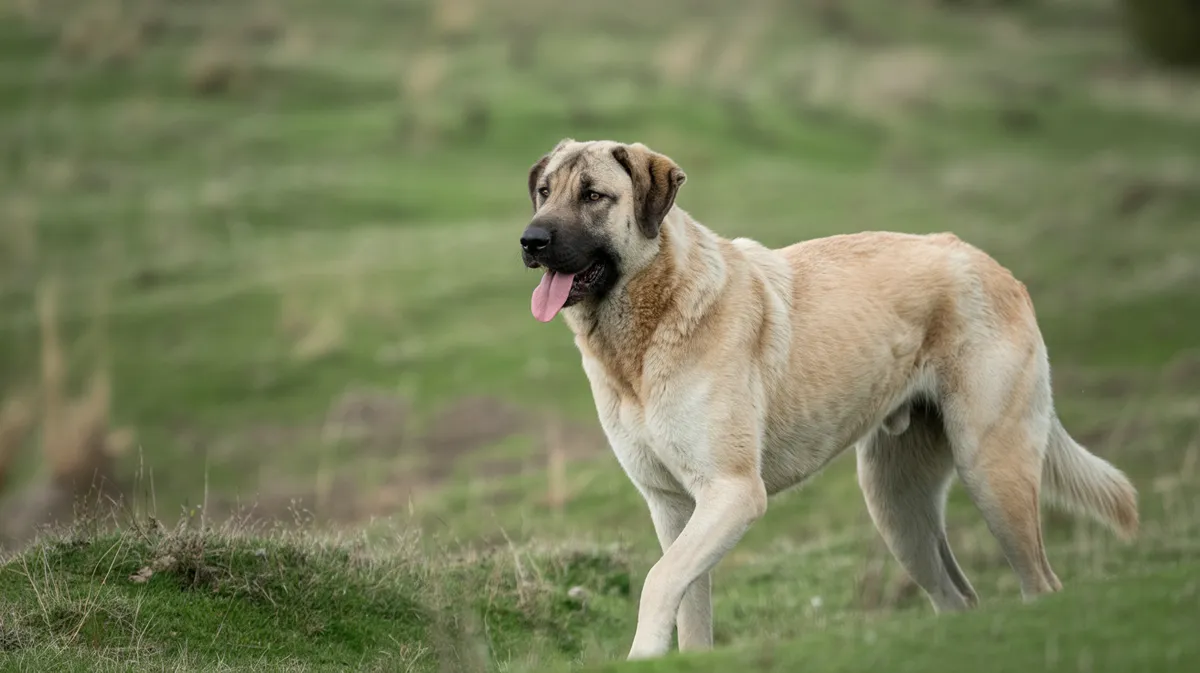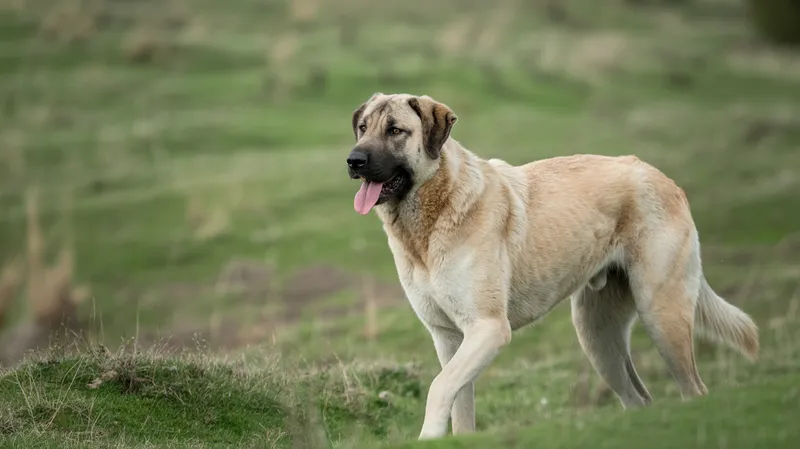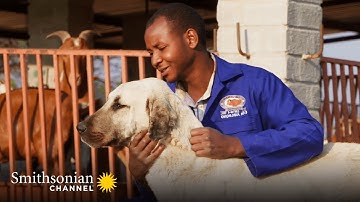
Kangal Shepherd Dog
Canis lupus familiaris

Meet the Kangal Shepherd Dog
The Kangal Shepherd Dog is a large, powerful livestock guardian breed originating from the Sivas province in central Turkey. Known for its impressive strength, intelligence, and loyalty, the Kangal has been bred for centuries to protect flocks from predators such as wolves and bears. With its dense, double-layered coat and imposing stature, the Kangal is both an effective working dog and a devoted companion. Its calm temperament, combined with a natural protective instinct, makes it highly valued among shepherds and farmers in its native region. The breed is recognized for its distinctive black mask and pale, fawn-colored coat.
Classification
Mammal
Habitat
Grasslands and rural farmlands
Diet
Omnivore
Lifespan
12-15 years
Conservation
Least Concern
Weight
40–65 kg (88–143 lbs)
📖Fascinating Facts
Exceptional Guardian
Kangals have been used for centuries to protect livestock from wolves, jackals, and even bears, often working independently in rural Turkish landscapes.
Powerful Build
This breed is renowned for its muscular frame and has a bite force measured at over 700 PSI, making it one of the strongest among domestic dogs.
Distinctive Appearance
The Kangal Shepherd Dog is easily identified by its short, dense, pale fawn coat and a pronounced black facial mask.
📋Detailed Description
The Kangal Shepherd Dog is a robust, large-boned breed, typically weighing between 48–60 kg (106–132 lbs) for males and 40–50 kg (88–110 lbs) for females, with males standing 70–80 cm (27.5–31.5 in) at the shoulder and females 63–75 cm (24.8–29.5 in). Its physique is characterized by a broad skull, powerful jaws, and a muscular, well-proportioned body built for endurance and agility. The breed’s dense, double-layered coat, ranging from 3 to 7 cm in length, provides insulation against extreme Anatolian climates, from harsh winters to hot summers. The coat color varies from pale fawn to wolf grey, always accompanied by a distinct black mask and often black ears. Kangals are renowned for their calm, steady temperament and acute awareness, making them highly effective at detecting and deterring predators. Socially, they exhibit strong pack instincts, forming close bonds with livestock and humans alike, and are known for their low reactivity to novel stimuli, which is crucial for their guardian role. Their deep chest and strong limbs allow for bursts of speed—documented at up to 50 km/h (31 mph)—enabling them to confront and chase off large predators. The breed’s vocalizations are typically reserved for alerting, rather than aggression, and their imposing presence alone often suffices to deter threats. Kangal Shepherd Dogs are highly intelligent, capable of independent decision-making, and display a remarkable balance of protectiveness and gentleness, especially with children and familiar animals.
💡 Did you know?
Despite their intimidating size and power, Kangals are known for being gentle and protective with children.
🔬Research & Sources
Wikipedia Summary
The Kangal Shepherd Dog is a traditional Turkish breed of large livestock guardian dog. The breed name derives from that of the town and district of Kangal in Sivas Province, the easternmost province of the Central Anatolia Region in central Turkey. The coat colour varies from pale fawn to wolf grey, always with a black mask.
Last Modified: 6/8/2025
🎭Behavior & Social Structure
Kangal Shepherd Dogs are diurnal, remaining vigilant throughout the day and night, often patrolling the perimeters of their territory. Their primary behavioral pattern is protective vigilance, maintaining a watchful distance from the flock while scanning for potential threats. Unlike herding breeds, Kangals do not drive livestock but instead position themselves strategically to intercept predators. They are known for their low prey drive toward livestock but will respond assertively to unfamiliar canids or large carnivores. Feeding behavior is opportunistic; while primarily fed by humans in working contexts, they may supplement their diet with small mammals or carrion if available. Socially, Kangals are pack-oriented, displaying clear dominance hierarchies when kept in groups, but they are generally tolerant and cooperative with other working dogs. They communicate through body language, vocalizations, and scent marking. Daily routines involve alternating periods of rest, patrol, and interaction with livestock and humans, with increased activity during dawn and dusk when predator threats are highest.
👶Reproduction & Life Cycle
Kangal Shepherd Dogs reach sexual maturity at approximately 18–24 months. The breed is monoestrous, with females typically coming into heat once a year, usually in late winter or early spring, aligning with traditional lambing seasons. Mating is preceded by courtship behaviors, including scent marking and mutual grooming. The gestation period averages 60–63 days, after which litters of 5–10 puppies are born. Maternal care is pronounced, with the dam providing warmth, protection, and nursing for the first 4–6 weeks. Weaning occurs gradually, with puppies beginning to consume solid food at 3–4 weeks. Socialization with livestock and humans is critical during early development to ensure proper guardian behavior. Breeding practices in Turkey often emphasize working ability and temperament over appearance, with selective breeding managed by local shepherds and, more recently, by breed organizations.
🛡️Adaptations & Survival
The Kangal’s thick, double-layered coat is a key adaptation, providing thermal insulation against both cold and heat, as well as protection from bites. Their large size and muscular build enable them to physically confront predators such as wolves and bears. The breed’s acute senses—particularly hearing and scent—facilitate early detection of threats. Behavioral adaptations include low reactivity to livestock, high tolerance for environmental stressors, and an innate ability to assess risk independently. Their calm demeanor reduces the likelihood of unnecessary aggression, conserving energy for genuine threats. Evolutionarily, Kangals have been selected for both physical prowess and psychological stability, traits essential for effective livestock guardianship in the challenging Anatolian landscape.
📚Research Sources
🎨Cultural Significance
The Kangal Shepherd Dog holds a revered place in Turkish culture, especially in the Sivas region, where it is considered a national treasure and symbol of rural heritage. The breed is celebrated in local folklore, poetry, and festivals, often depicted as a loyal and courageous protector. Kangals are traditionally gifted to visiting dignitaries and have been used as diplomatic symbols. Their image appears on Turkish postage stamps and coins. The breed’s reputation for bravery and loyalty has contributed to its status as a living emblem of Anatolian pastoral life. In recent decades, Kangals have also gained international recognition as guardians of livestock in conservation projects across Africa, Europe, and North America.
🔬Recent Research & Discoveries
Recent genetic studies have confirmed the distinctiveness of the Kangal Shepherd Dog compared to other Turkish and regional livestock guardian breeds, supporting its recognition as a separate breed. Research has focused on the breed’s effectiveness in reducing livestock losses to predators, with studies in Namibia and the United States demonstrating significant decreases in predation when Kangals are employed. Ongoing research addresses the breed’s genetic diversity, health status, and optimal management practices for working and companion contexts. There is also interest in the breed’s behavioral ecology, particularly its decision-making processes and interactions with both livestock and wildlife. Conservation organizations are collaborating with Turkish authorities to establish breeding standards and maintain genetic integrity.
🎥Wildlife Videos

A Shepherd's Best Friend | Wild Turkey
About National Geographic Wild: National Geographic Wild is a place for all things animals and for animal-lovers alike. Take a ...
Nat Geo Animals

TURKISH KANGAL DOG - WOLF KILLER OR PET?
Anneka meets two guardians of the Kangal - Carl Westfield of Zoetrope Kangals and top UK Kangal Expert Sheila Reed and ...
Animal Watch

This Anatolian Guard Dog Protects Both Livestock & Predators | Smithsonian Channel
Captain is an Anatolian guard dog responsible not only for protecting his master's herd of goats. He's also indirectly causing fewer ...
Smithsonian Channel

Kangal Dog vs Cane Corso | Animated | Wildlife Documentary | Informative #biography#wildlbirds
Kangal Dog vs Cane Corso | Animated | Wildlife Documentary | Informative ...
Animals World.official

"𝟒 𝐅𝐞𝐚𝐫𝐥𝐞𝐬𝐬 𝐃𝐨𝐠 𝐁𝐫𝐞𝐞𝐝𝐬 𝐓𝐡𝐚𝐭 𝐂𝐚𝐧 𝐓𝐚𝐤𝐞 𝐨𝐧 𝐚 𝐖𝐨𝐥𝐟!" #kangal #ytshorts #reels #wildlife #facts #animals
Meet the ultimate guardians of the animal world—dog breeds so fearless, they can take on a gray wolf! From the powerful ...
Buzzing Brain

What are the amazing powers and surprising weaknesses of the Kangal Dog?
dog #strongest #kangaldog #shorts #animal #animals #animalfacts #animaldocumentary #nature #science #wildlife ...
Animal Unfortunate Facts
🌍Habitat Information
The Kangal Shepherd Dog typically inhabits Grasslands and rural farmlands environments. Kangal Shepherd Dogs have adapted to their environments with specialized features and behaviors.
Primary Habitat:
Grasslands and rural farmlands
More detailed habitat information will be available soon.
🛡️Conservation Status
The Kangal Shepherd Dog is currently classified as Least Concern. Conservation efforts are crucial for preserving this species for future generations.
Common Threats:
- 🏠Habitat loss and fragmentation
- 🌡️Climate change impacts
- 🎯Hunting and poaching
- 🏭Human-wildlife conflict
⚠️Threats & Conservation Challenges
While the Kangal Shepherd Dog is not considered threatened as a breed, it faces several challenges. Modernization of agriculture and declining traditional pastoralism in Turkey have reduced the demand for working livestock guardians. Crossbreeding with other large breeds, both within Turkey and abroad, poses a risk to genetic purity and traditional working traits. There are also concerns about overbreeding for export, which may prioritize appearance over functional ability. In some regions, increased use of poison or firearms against predators has diminished the perceived need for guardian dogs. However, the breed remains valued in conservation programs aimed at reducing human-wildlife conflict, particularly in efforts to protect livestock from large carnivores without resorting to lethal control.
🔬Scientific Classification
Scientific Name
Canis lupus familiaris
Classification Hierarchy
🔍 About Taxonomic Classification
Taxonomic classification is a hierarchical system used by scientists to classify and organize living organisms based on shared characteristics and evolutionary relationships.
The system moves from broad categories (Kingdom) to increasingly specific ones, with each animal's scientific name typically consisting of its Genus and species.
📝Community Notes
Share your observations and insights about the Kangal Shepherd Dog with our community of wildlife enthusiasts.
Join Our Community
Sign in to share your observations and connect with fellow wildlife enthusiasts.
Sign In to ContributeNo community notes yet
Be the first to share your observations about the Kangal Shepherd Dog!
Explore Kangal Shepherd Dog
Select a tab above to learn more about this amazing animal.
📸Photo Gallery
No photos available for this animal yet.
🌟Discover More Wildlife
Continue your journey of discovery with more fascinating animals from our database
